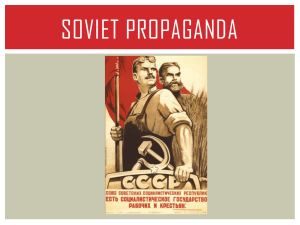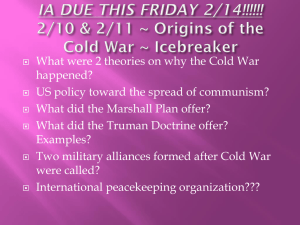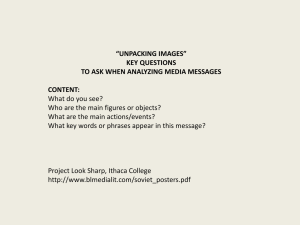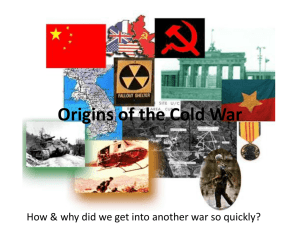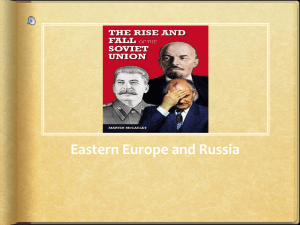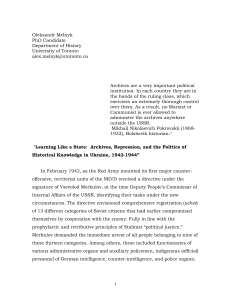Talk at Katyń conference, Library of Congress, Washington, DC, 5
advertisement
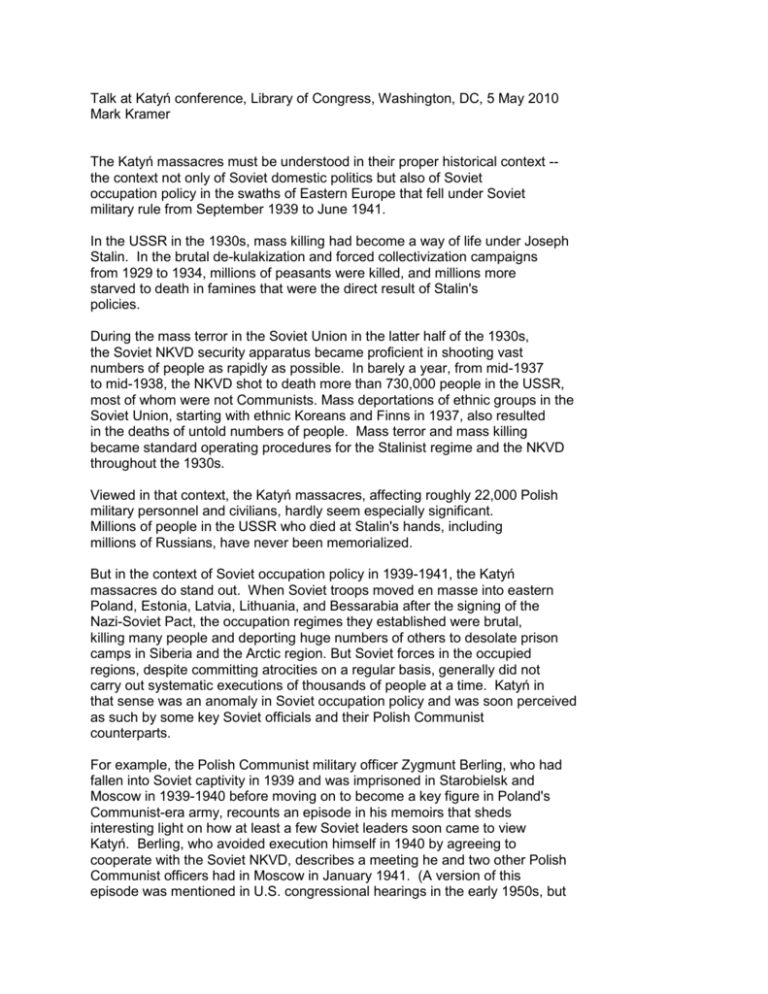
Talk at Katyń conference, Library of Congress, Washington, DC, 5 May 2010 Mark Kramer The Katyń massacres must be understood in their proper historical context -the context not only of Soviet domestic politics but also of Soviet occupation policy in the swaths of Eastern Europe that fell under Soviet military rule from September 1939 to June 1941. In the USSR in the 1930s, mass killing had become a way of life under Joseph Stalin. In the brutal de-kulakization and forced collectivization campaigns from 1929 to 1934, millions of peasants were killed, and millions more starved to death in famines that were the direct result of Stalin's policies. During the mass terror in the Soviet Union in the latter half of the 1930s, the Soviet NKVD security apparatus became proficient in shooting vast numbers of people as rapidly as possible. In barely a year, from mid-1937 to mid-1938, the NKVD shot to death more than 730,000 people in the USSR, most of whom were not Communists. Mass deportations of ethnic groups in the Soviet Union, starting with ethnic Koreans and Finns in 1937, also resulted in the deaths of untold numbers of people. Mass terror and mass killing became standard operating procedures for the Stalinist regime and the NKVD throughout the 1930s. Viewed in that context, the Katyń massacres, affecting roughly 22,000 Polish military personnel and civilians, hardly seem especially significant. Millions of people in the USSR who died at Stalin's hands, including millions of Russians, have never been memorialized. But in the context of Soviet occupation policy in 1939-1941, the Katyń massacres do stand out. When Soviet troops moved en masse into eastern Poland, Estonia, Latvia, Lithuania, and Bessarabia after the signing of the Nazi-Soviet Pact, the occupation regimes they established were brutal, killing many people and deporting huge numbers of others to desolate prison camps in Siberia and the Arctic region. But Soviet forces in the occupied regions, despite committing atrocities on a regular basis, generally did not carry out systematic executions of thousands of people at a time. Katyń in that sense was an anomaly in Soviet occupation policy and was soon perceived as such by some key Soviet officials and their Polish Communist counterparts. For example, the Polish Communist military officer Zygmunt Berling, who had fallen into Soviet captivity in 1939 and was imprisoned in Starobielsk and Moscow in 1939-1940 before moving on to become a key figure in Poland's Communist-era army, recounts an episode in his memoirs that sheds interesting light on how at least a few Soviet leaders soon came to view Katyń. Berling, who avoided execution himself in 1940 by agreeing to cooperate with the Soviet NKVD, describes a meeting he and two other Polish Communist officers had in Moscow in January 1941. (A version of this episode was mentioned in U.S. congressional hearings in the early 1950s, but some important details in that version are incorrect. The version in Berling's posthumously published memoir is authoritative.) Berling recounts that he and his two Polish colleagues were brought to speak with Lavrentii Beria, the head of the state security apparatus, and Vsevolod Merkulov, Beria's deputy (who became head of the state security apparatus a few months later when it was separated from the NKVD). When Berling gave to Beria and Merkulov a list of names of officers who had been imprisoned at Kozielsk and Starobielsk, hoping to find out whether any had been brought to Moscow, Beria told them "We have no such people now in the Soviet Union." Merkulov added: "We committed a big mistake with them" (Popelniliśmy z nimi wielką omyłkę). For some 47 years after German forces discovered mass graves in Katyń Forest in 1943, the Soviet authorities stuck to the lie that German troops were responsible for the massacres. But we now know from declassified archival materials that Soviet Communist Party leaders from Nikita Khrushchev through Mikhail Gorbachev reviewed documents and, in some cases, considered whether the Soviet government should acknowledge responsibility for the massacres. Not until April 1990, however, did Gorbachev (who had recently taken up the new post of Soviet president) finally acknowledge that Soviet troops had committed the murders. The official TASS statement, issued on 13 April 1990, described the Katyń massacres as "one of the most odious crimes of Stalinism" -- a characterization that, in light of the long list of mass atrocities perpetrated by Stalin's regime, underscores Soviet leaders' own recognition that Katyń, despite accounting for only a minuscule percentage of the total number of Stalin's victims, was among the worst excesses. If Soviet leaders themselves recognized that Katyń was in some way special, we can easily understand why Poles -- both inside and outside Poland --were so focused after 1940 on establishing the truth about Katyń. Long before any relevant Soviet archival materials became available, the basic truth about Katyń was known in the West, but starting in 1990 the release of key archival documents in Moscow confirmed what was known and added many crucial details, including incontrovertible evidence of Stalin's personal culpability. Unfortunately, in 2004 under then-President Vladimir Putin, the official investigation of the Katyń murders that had begun in Moscow in 1990 was halted, and all materials connected with the investigation were sealed. As a result, researchers have been unable to prepare complete lists of the names of victims and complete lists of the names of NKVD personnel who organized and carried out the mass executions. Thus far, the only partial roster we have of the NKVD executioners is a list from the former Soviet state security archive of NKVD regional officials who were given awards by Beria for their role in "clearing out" the three "special camps" (Kozielsk, Starobielsk, Ostashkov) where the Polish prisoners were held. The list is very important but is incomplete and does not indicate which officials actually did the shooting. Other documents reveal the names of four state security officers -- Nikolai Murashov, Pavel Dulemba, Timofei Kachin, and Mikhail Kozochskii -- who oversaw the transport of Polish prisoners from Ostashkov to killing sites in Kalinin/Tver. In the early 1990s, two key participants in the massacres, Dmitrii Tokarev (who was head of the NKVD branch in the Kalinin/Tver region in 1940) and Mitrofan Syromyatnikov (who was a senior guard and later a lieutenant at the Kharkiv prison), gave detailed testimony that revealed the identities of two people -- Vasilii Blokhin and Timofei Kuprii -- who evidently were among the shooters in Kalinin/Tver and Kharkiv, respectively. Tokarev also mentioned two senior state security officials, Mikhail Krivenko and Nikolai Sinegubov, who he said came from Moscow to organize the transport of prisoners to the killing sites in Kalinin/Tver, where Blokhin coordinated the executions. Tokarev also claimed that Andrei Rubanov, another state security officer, was among those who held the Polish prisoners down as they were being shot. But even if Tokarev's and Syromyatnikov's testimony is fully reliable, it gives us only a few pieces of a much larger puzzle -- a puzzle that can be put together only on the basis of NKVD operational documents that have not yet been released. Why is it important for Poles, Russians, and others to have a full list not only of the names of the victims but also of the names of the perpetrators at all levels? Let me illustrate this by referring to Soviet occupation policy in another area of Eastern Europe at that time, specifically Latvia. Soviet forces moved into Latvia in the fall of 1939 and enforced a harsh occupation regime over the next year-and-a-half. In June 1941, eight days before Germany's attack on the USSR, the Soviet NKVD and NKGB carried out mass deportations in Latvia, Lithuania, and Estonia. Since 1991, the Latvian, Lithuanian, and Estonian governments have compiled books listing the names of all the victims of the mass deportations of 13-14 June 1941 as well as the victims of further mass deportations carried out by Soviet forces in the early postwar years. Among those deported from Latvia to Gulag camps in Siberia were 27 members of my father's family (seven close relatives and twenty more distant), who were Latvian Jews. Their names are listed with many thousands of others in the series of booklets titled Repres?to Saraksts 1941-1953 (List of the Repressed, 1941-1953), put out by the State Archive of the Latvian Republic (Latvijas Republikas Valsts arh?vu ?ener?ldirekcija) in the mid-1990s. The NKVD separated my father's uncles and male cousins from his aunts and female cousins and sent all of them in boxcars to several prison camps in Siberia. Six of his seven closest relatives died of malnutrition or dysentery within months of arriving at the Gulag sites, and only one made it back alive to Riga from the prison camps some sixteen years later, several years after Stalin died. Eighteen of his twenty more distant relatives also died quickly in the Gulag, and one made it back alive in the mid-1950s. The final member of my father's family, Aleah Kleimana, also died, but not in the Gulag. On the day of the deportations, 14 June 1941, when she was 18 years old and about to start her higher education, an NKVD officer grabbed her and attempted to rape her. She desperately tried to fight him off, and he, in his fury, took his gun and beat her to death. After I found out about this incident in the 1990s, I attempted to track down the identity of the NKVD officer who assaulted and murdered my cousin. I did not intend to seek physical revenge against the person or his descendants, but I did feel it was important to ensure that his name was publicly known forever along with the appalling crime he committed. In ordinary life we believe it is important to bring criminals to justice. It was too late for that with my cousin's murderer, but at least I could ensure that his identity would be known and would be held in eternal infamy. When I went to the reading room at the Lubyanka where Russians and others are allowed to request case files pertaining to relatives who were repressed during the Stalin years, the archivists told me that they would "never" (nikogda) release the names of the NKVD personnel who carried out the mass deportations. When I told them that I wanted to track down the identity of a specific individual who had wantonly raped and murdered one of the deportees, they said they would offer no help and requested that I leave the premises. As I think back to my own deep anger and frustration in encountering the former KGB's refusal to make any information available about the perpetrators of mass deportations in the Baltic countries, I can better understand why many Poles feel such an overriding need to establish a register of names of those at all levels who perpetrated the Katyń massacres, indicating who did what. We now know beyond doubt the names of those who gave the orders for the Katyń crime -- Stalin and his top henchmen -- and we also know the names of all of the NKVD regional personnel who received awards for their roles in the massacres. But we do not yet have contemporaneous documentation regarding the precise functions that these NKVD officials performed -- which of them transmitted the orders, which of them brought in the many thousands of prisoners, and which of them actually did the shooting. The recollections of Tokarev and Syromyatnikov shed some light on the matter, but a great deal needs to be clarified from NKVD records that are still sealed. The compilation of a detailed list of NKVD officials and the specific tasks they carried out in the Katyń massacres will not bring any of the victims back to life and will not bring any of the perpetrators to justice, but it will help ensure that historical memory of the Katyń tragedy is complete. After decades of falsification and stonewalling, it is time for the full truth of the matter to be revealed. This presentation is from the 70th Katyn observances at the Coolidge Auditorium of the Library of Congress, May 5, 2010. This is sent with permission of Professor Mark Kramer and the Harvard University Cold War Archives. It can be reprinted or reposted with acknowledgment




